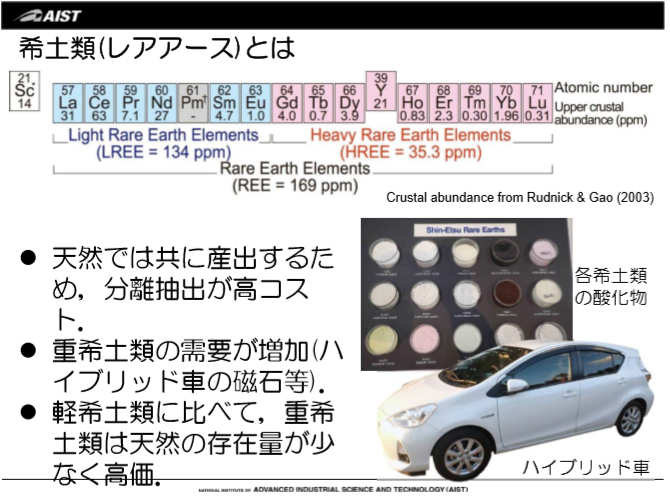
|
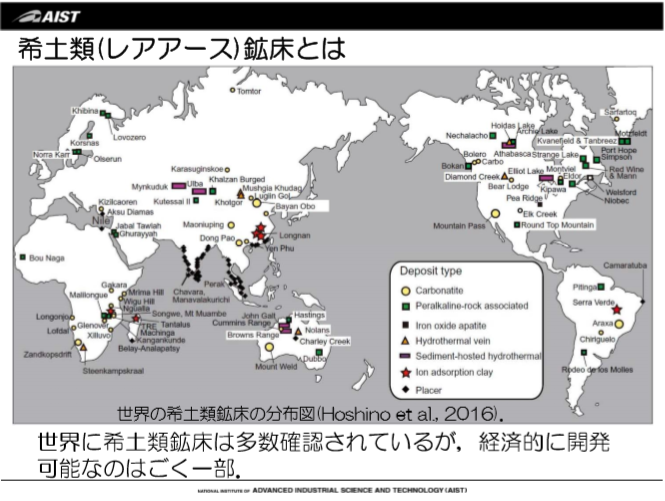
|
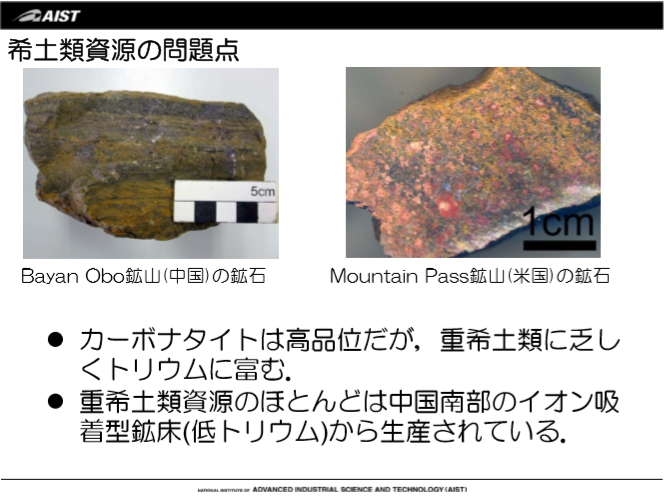
|
|
|
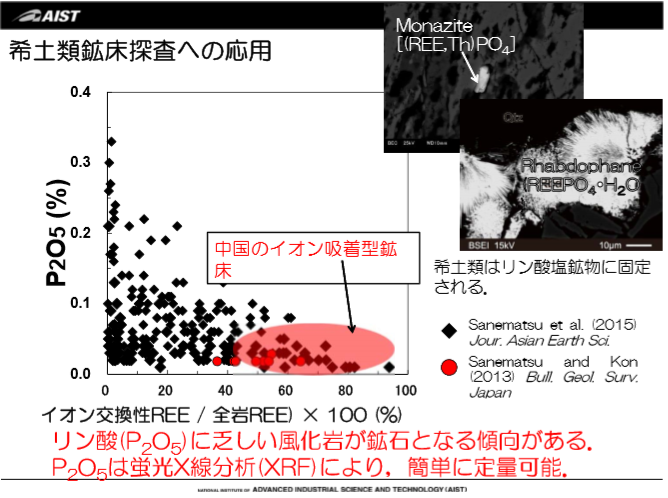
|
| 実松健造による『鉱床の成因研究と探査への応用』(2017/12/7)から | |
|
|
最終更新日:2019年1月4日
| レアアース(Rare Earth Elements、REE、希土類元素)は、レアメタルの中でも代表的な元素群であり、原子番号57番ランタン(La)〜71番ルテチウム(Lu)のランタノイド(Lanthanoid)に、21番スカンジウム(Sc)および39番イットリウム(Y)を加えた計17種類を指す。狭義にランタノイドのみをレアアースと呼ぶ人もいる。 |

|

|

|
|
|

|
| 実松健造による『鉱床の成因研究と探査への応用』(2017/12/7)から | |
/Image1331.gif) 図1. レアアースの用途 |
/Image1332.gif) 図2. 世界のレアアース生産推移 |
/Image1333.gif) 図6. レアアースの価格推移 |
/Image1335.gif) 注) 2005 年以降は新金属協会非会員分も含む (出典 新金属協会) |
/Image1334.gif) |
/Image1336.gif) 図7. レアアース問題の整理 |
| 馬場(2014/9)による『レアアース問題の整理−供給リスクは減少?−』から | |
/Image1327.gif) 図2-1 太平洋におけるレアアース泥の分布(<2mの表層部)と平均総レアアース含有量 |
/Image1328.gif) 図2-2 南鳥島周辺の排他的経済水域内及び周辺のレアアース泥の分布とレアアース含有量 |
/Image1329.gif) 図4-1-1 レアアース泥調査海域 |
/Image1330.gif) |
| JOGMEC(2013/11)による『南鳥島海域のレアアース泥に関する勉強会報告書【調査・研究実施計画】』から | |
/Image2174.gif) /Image2175.gif) 馬場(2012/2)による『レアアース資源問題』から |
/Image1919.gif) |
|
/Image1920.gif) 世界のレアアース資源の分布 |
|
/Image1921.gif) レアアースの埋蔵量【左】と生産量(2008年)(酸化物量、単位千トン)【右】 |
|
/Image1922.gif) 2タイプのレアアース鉱床 |
|
/Image1923.gif) レアアース生産国の推移(1190〜2009年) |
/Image1924.gif) |
| JOGMEC(HP/2012/6)による『レアアースの通説 正と誤』から | |
/Image1931.gif) 図1 太平洋におけるレアアース泥の分布 深海堆積物の海底面下2m(最上部2m)部分のΣREYの平均値。400ppm以上はレアアース資源としてのポテンシャルを有している。 |
ΣREY=レアアース15元素とイットリウムの総含有量 ΣHREE=相対的に重いレアアースであるガドリニウムからルテシウムまでの8元素の総含有量 レアアース泥は、 (1)中国の陸上鉱床(イオン吸着型鉱床)に匹敵する高いレアアース含有量を持つこと(ΣREY=400〜2,230ppm、ΣHREE=70〜430ppm)、 (2)資源量が膨大かつ探査が容易なこと、 (3)開発の障害となるトリウムやウランなどの放射性元素をほとんど含まないこと、 (4)希硫酸や希塩酸で容易にレアアースが抽出可能であり、その回収が極めて容易なこと の特徴を示す。 |
| 加藤(2012)による『新しい海底鉱物資源“レアアース泥”の発見とその開発を目指して』から | |
/Image978.gif) 図1. レアアース鉱石の生産国推移 廣川(2011)による『レアメタルシリーズ2011レアアースの需要・供給及び価格の動向』から |
金属企画調査部(2011)による『米国エネルギー省クリティカル物質戦略の需給予測』から |
/Image11.gif) 図22. 世界のレアアース鉱床の分布 美濃輪(2011)による『レアメタルシリーズ2010 希土類磁石から見たレアメタルと磁石応用の今後』から |
|
|
|
|
|
|
|
|
||
| 中国 | 120,000 | 120,000 | 36,000,000 |
| HIS(Commonwealth of Independent States) | NA | NA | 19,000,000 |
| 米国 | − | − | 13,000,000 |
| オーストラリア | − | − | 5,400,000 |
| インド | 2,700 | 2,700 | 3,100,000 |
| ブラジル | 650 | 650 | 48,000 |
| マレーシア | 380 | 380 | 30,000 |
| その他 | NA | NA | 22,000,000 |
|
|
124,000 | 124,000 | 99,000,000 |
|
NA=Not available。 CIS=独立国家共同体:旧ソビエト連邦の12カ国で形成された緩やかな国家連合体。 |
|||
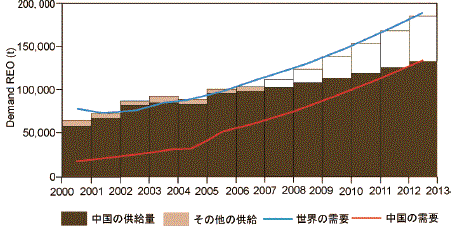 図2 希土類元素の需要と供給予測(Roskill, 2007) 渡辺・実松・守山(2008)による『鉱物資源研究グループの希土類資源調査の現状』から |
/Image1925.gif) 図1 層状マンガン鉱床及び花崗岩風化型鉱床の希土類元素含有量。層状鉄マンガン鉱床は希土類含有量(棒グラフの高さ)が高く、かつ重希土類元素(グラフの奥行き軸)に富むことを特徴とする。右側の写真は代表的な鉄マンガン鉱石とマンガン鉱石。 |
/Image1926.gif) 図2 重希土類元素とマンガン・鉄含有量との関係 |
||||||||||||||||
|
|||||||||||||||||
| (独)産業技術総合研究所による『重希土類元素に富む層状マンガン鉱床の特徴を把握』から | |||||||||||||||||
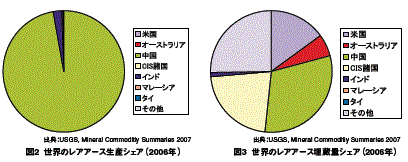 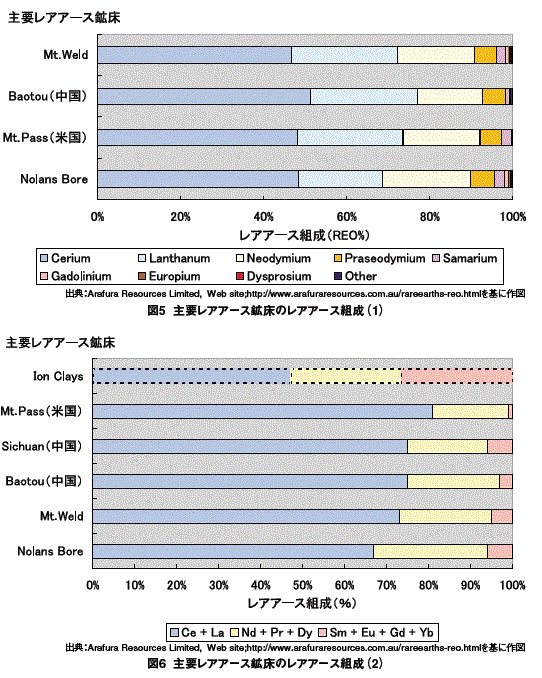  久保田(2007)による『オーストラリアのレアメタル資源の現状 2007 年 ― レアアース編―』から |
石原・村上(2006)による『レアアース資源を供給する鉱床タイプ』から |
|||||||||||||||||||||||||||||||||||||||||||||||||||||||||||||||||||||||||||||||||||||||||||||||||||||||||||||||||||||||||||
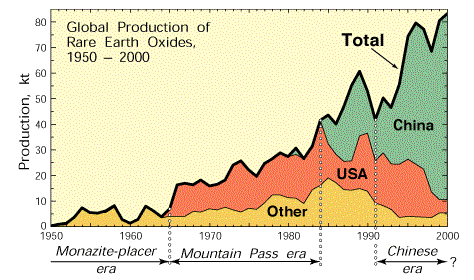 Figure 1. Global rare earth element production (1 kt=106 kg) from 1950 through 2000, in four categories: United States, almost entirely from Mountain Pass, California; China, from several deposits; all other countries combined, largely from monazite-bearing placers; and global total. Four periods of production are evident: the monazite-placer era, starting in the late 1800s and ending abruptly in 1964; the Mountain Pass era, starting in 1965 and ending about 1984; a transitional period from about 1984 to 1991; and the Chinese era, beginning about 1991. |
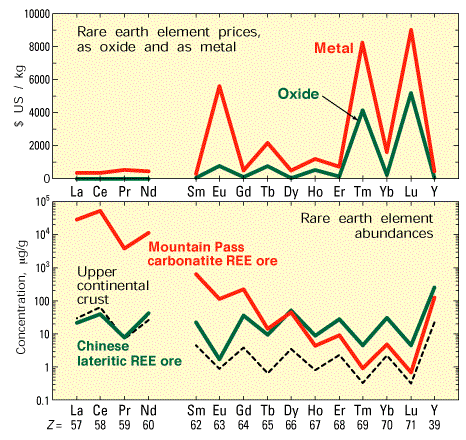 Figure 3. Prices and abundances of the rare earth elements. Prices are for 1999 or 2000 in U.S. dollars per kilogram of REE metal, in two forms: (1) as oxides, in 2 to 25 kg packages, at 95 to 99.99% purity; (2) as 0.1 to 0.45 kg metal ingot, at 99.9% purity. Two representative REE ores−high-grade carbonatite ore from Mountain Pass, California, and lateritic ion-adsorption ore from southern China−are compared with Earth’s upper continental crust. Z, atomic number. |
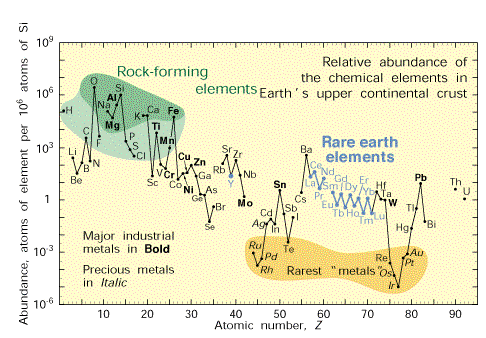 Figure 4. Abundance (atom fraction) of the chemical elements in Earth’s upper continental crust as a function of atomic number. Many of the elements are classified into (partially overlapping) categories: (1) rock-forming elements (major elements in green field and minor elements in light green field); (2) rare earth elements (lanthanides, La-Lu, and Y; labeled in blue); (3) major industrial metals (global production >〜3x107 kg/year; labeled in bold); (4) precious metals (italic); and (5) the nine rarest “metals”−the six platinum group elements plus Au, Re, and Te (a metalloid). |
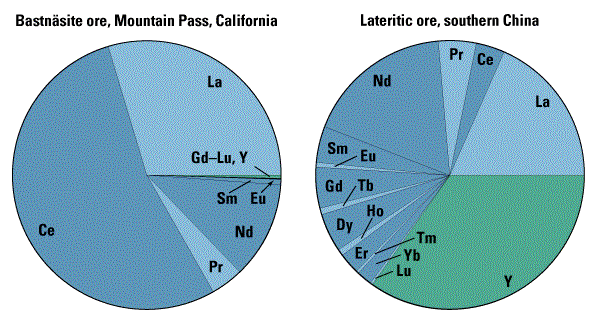 Figure 6. Proportions of individual REE in two representative ores: bastnasite, dominated by La, Ce, and Nd, with Eu through Lu plus Y totaling only 0.4%; and lateritic ion-adsorption ore, Y-dominated. Dark blue and light blue sectors represent lanthanides of even and odd atomic number, respectively (see figs. 2, 3). Yttrium is indicated by green. |
| USGS(2002)による『Rare Earth Elements−Critical Resources for High Technology』から | |
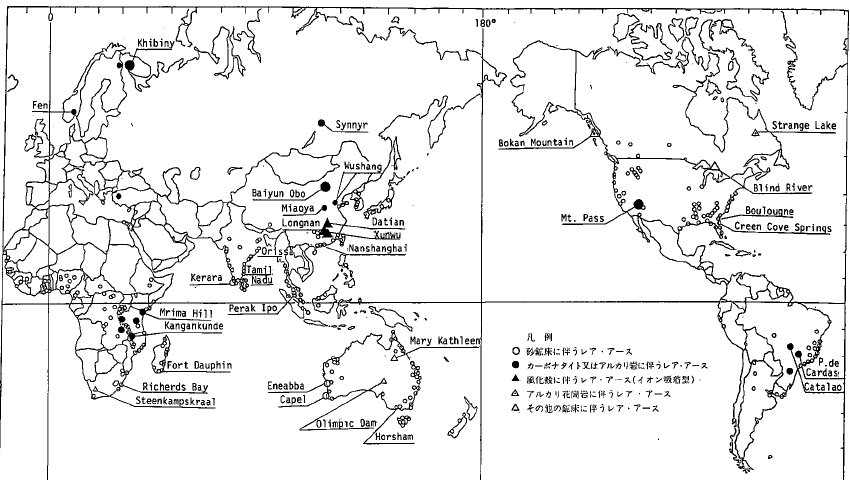 第1図 世界のレアアース鉱床分布図 神谷(1989)による『世界のレアアース資源』から |